
Concept explainers
(a)
The point to which a voltmeter is connected to measure the potential difference of the voltage source in the given figure.
Answer to Problem 26CQ
Explanation of Solution
Given information:
The given figure is
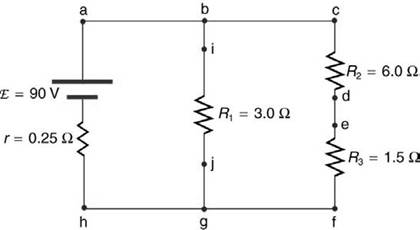
Introduction:
Ammeter is connected in series in the circuit to measure the current.
Voltmeter is connected in parallel in the circuit to measure the voltage.
Ammeter is a device which is used to measure the current in the circuit and is connected in series in the circuit.
It is having internal impedance whose value is zero.
Voltmeter is connected in parallel in the circuit to measure the voltage.
It is having internal impedance whose value is infinity.
In order to measure a potential difference of the voltage source the voltmeter must be connected between the points
Conclusion:
All the currents going into the junction are positive.
(b)
The point to which a voltmeter is connected to measure the potential difference across
Answer to Problem 26CQ
Explanation of Solution
Given information:
The given figure is
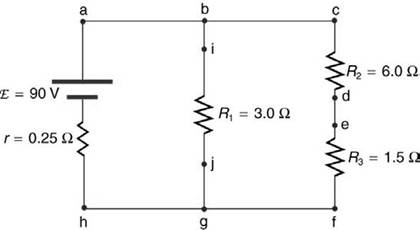
Introduction:
Ammeter is connected in series in the circuit to measure the current.
Voltmeter is connected in parallel in the circuit to measure the voltage.
Ammeter is a device which is used to measure the current in the circuit and is connected in series in the circuit.
It is having internal impedance whose value is zero.
Voltmeter is connected in parallel in the circuit to measure the voltage.
It is having internal impedance whose value is infinity.
In order to measure a potential difference across
Conclusion:
The point to which a voltmeter is connected to measure the potential difference across
(c)
The point to which a voltmeter is connected to measure the potential difference across
Answer to Problem 26CQ
Explanation of Solution
Given information:
The given figure is
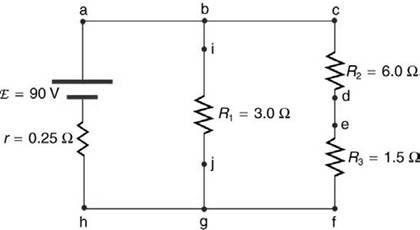
Introduction:
Ammeter is connected in series in the circuit to measure the current.
Voltmeter is connected in parallel in the circuit to measure the voltage.
Ammeter is a device which is used to measure the current in the circuit and is connected in series in the circuit.
It is having internal impedance whose value is zero.
Voltmeter is connected in parallel in the circuit to measure the voltage.
It is having internal impedance whose value is infinity.
In order to measure a potential difference across
Conclusion:
The point to which a voltmeter is connected to measure the potential difference across
(d)
The point to which a voltmeter is connected to measure the potential difference across
Answer to Problem 26CQ
Explanation of Solution
Given information:
The given figure is
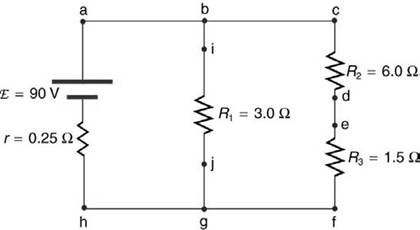
Introduction:
Ammeter is connected in series in the circuit to measure the current.
Voltmeter is connected in parallel in the circuit to measure the voltage.
Ammeter is a device which is used to measure the current in the circuit and is connected in series in the circuit.
It is having internal impedance whose value is zero.
Voltmeter is connected in parallel in the circuit to measure the voltage.
It is having internal impedance whose value is infinity.
In order to measure a potential difference across
Conclusion:
The point to which a voltmeter is connected to measure the potential difference across
(e)
The point to which a voltmeter is connected to measure the potential difference across
Answer to Problem 26CQ
Explanation of Solution
Given information:
The given figure is
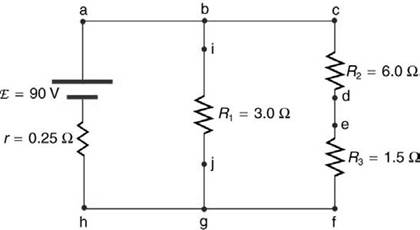
Introduction:
Ammeter is connected in series in the circuit to measure the current.
Voltmeter is connected in parallel in the circuit to measure the voltage.
Ammeter is a device which is used to measure the current in the circuit and is connected in series in the circuit.
It is having internal impedance whose value is zero.
Voltmeter is connected in parallel in the circuit to measure the voltage.
It is having internal impedance whose value is infinity.
In order to measure a potential difference across
Conclusion:
The point to which a voltmeter is connected to measure the potential difference across
Want to see more full solutions like this?
Chapter 21 Solutions
College Physics
- A 15.8-mW laser puts out a narrow beam 2.0 mm in diameter.Suppose that the beam is in free space. What is the rms value of E in the beam? What isthe rms value of B in the beam?Prob. 28, page 834. Ans: Erms= 1380 V/m, Brms =4.59×10-6 Tarrow_forwardA 4.5 cm tall object is placed 26 cm in front of a sphericalmirror. It is desired to produce a virtual image that is upright and 3.5 cm tall.(a) What type of mirror should be used, convex, or concave?(b) Where is the image located?(c) What is the focal length of the mirror?(d) What is the radius of curvature of the mirror?Prob. 25, page 861. Ans: (a) convex, (b) di= -20.2 cm, i.e. 20.2 cm behind the mirror,(c) f= -90.55 cm, (d) r= -181.1 cm.arrow_forwardA series RCL circuit contains an inductor with inductance L=3.32 mH, and a generator whose rms voltage is 11.2 V. At a resonant frequencyof 1.25 kHz the average power delivered to the circuit is 26.9 W.(a) Find the value of the capacitance.(b) Find the value of the resistance.(c) What is the power factor of this circuit?Ans: C=4.89 μF, R=4.66 Ω, 1.arrow_forward
- A group of particles is traveling in a magnetic field of unknown magnitude and direction. You observe that a proton moving at 1.70 km/s in the +x-direction experiences a force of 2.06×10−16 N in the +y-direction, and an electron moving at 4.40 km/s in the −z-direction experiences a force of 8.10×10−16 N in the +y-direction. What is the magnitude of the magnetic force on an electron moving in the −y-direction at 3.70 km/s ? What is the direction of this the magnetic force? (in the xz-plane)arrow_forwardA particle with a charge of −5.20 nC is moving in a uniform magnetic field of B =−( 1.22 T )k^. The magnetic force on the particle is measured to be F=−( 3.50×10−7 N )i^+( 7.60×10−7 N )j^. Calculate the x component of the velocity of the particle.arrow_forwardIs it possible for average velocity to be negative?a. Yes, in cases when the net displacement is negative.b. Yes, if the body keeps changing its direction during motion.c. No, average velocity describes only magnitude and not the direction of motion.d. No, average velocity describes only the magnitude in the positive direction of motion.arrow_forward
- Tutorial Exercise An air-filled spherical capacitor is constructed with an inner-shell radius of 6.95 cm and an outer-shell radius of 14.5 cm. (a) Calculate the capacitance of the device. (b) What potential difference between the spheres results in a 4.00-μC charge on the capacitor? Part 1 of 4 - Conceptualize Since the separation between the inner and outer shells is much larger than a typical electronic capacitor with separation on the order of 0.1 mm and capacitance in the microfarad range, we expect the capacitance of this spherical configuration to be on the order of picofarads. The potential difference should be sufficiently low to avoid sparking through the air that separates the shells. Part 2 of 4 - Categorize We will calculate the capacitance from the equation for a spherical shell capacitor. We will then calculate the voltage found from Q = CAV.arrow_forwardI need help figuring out how to do part 2 with the information given in part 1 and putting it in to the simulation. ( trying to match the velocity graph from the paper onto the simulation to find the applied force graph) Using this simulation https://phet.colorado.edu/sims/cheerpj/forces-1d/latest/forces-1d.html?simulation=forces-1d.arrow_forwardI need help running the simulation to get the result needed.arrow_forward
- How can I remember this Formula: p = m × v where m is in kg and v in Meter per second in the best way?arrow_forwardHow can I remember the Formula for the impulsearrow_forwardA Geiger-Mueller tube is a radiation detector that consists of a closed, hollow, metal cylinder (the cathode) of inner radius ra and a coaxial cylindrical wire (the anode) of radius г (see figure below) with a gas filling the space between the electrodes. Assume that the internal diameter of a Geiger-Mueller tube is 3.00 cm and that the wire along the axis has a diameter of 0.190 mm. The dielectric strength of the gas between the central wire and the cylinder is 1.15 × 106 V/m. Use the equation 2πrlE = 9in to calculate the maximum potential difference that can be applied between the wire and the cylinder before breakdown occurs in the gas. V Anode Cathodearrow_forward
 College PhysicsPhysicsISBN:9781938168000Author:Paul Peter Urone, Roger HinrichsPublisher:OpenStax College
College PhysicsPhysicsISBN:9781938168000Author:Paul Peter Urone, Roger HinrichsPublisher:OpenStax College Physics for Scientists and Engineers: Foundations...PhysicsISBN:9781133939146Author:Katz, Debora M.Publisher:Cengage Learning
Physics for Scientists and Engineers: Foundations...PhysicsISBN:9781133939146Author:Katz, Debora M.Publisher:Cengage Learning College PhysicsPhysicsISBN:9781305952300Author:Raymond A. Serway, Chris VuillePublisher:Cengage Learning
College PhysicsPhysicsISBN:9781305952300Author:Raymond A. Serway, Chris VuillePublisher:Cengage Learning College PhysicsPhysicsISBN:9781285737027Author:Raymond A. Serway, Chris VuillePublisher:Cengage Learning
College PhysicsPhysicsISBN:9781285737027Author:Raymond A. Serway, Chris VuillePublisher:Cengage Learning
 Principles of Physics: A Calculus-Based TextPhysicsISBN:9781133104261Author:Raymond A. Serway, John W. JewettPublisher:Cengage Learning
Principles of Physics: A Calculus-Based TextPhysicsISBN:9781133104261Author:Raymond A. Serway, John W. JewettPublisher:Cengage Learning





